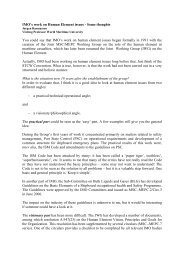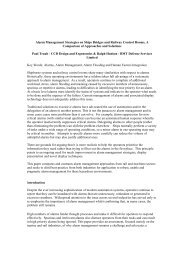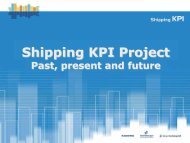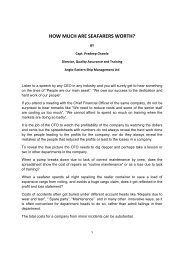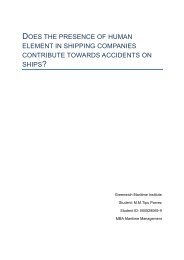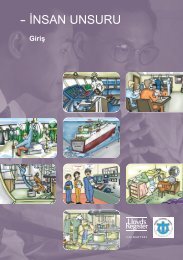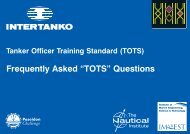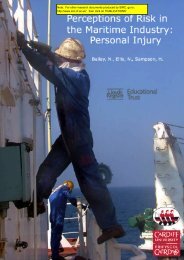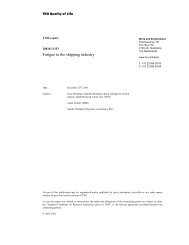Download PDF - Alert!
Download PDF - Alert!
Download PDF - Alert!
You also want an ePaper? Increase the reach of your titles
YUMPU automatically turns print PDFs into web optimized ePapers that Google loves.
During the recent economic boom, the industry faced<br />
a considerable shortage of seafarers. It would appear<br />
that the difficulty of finding suitably skilled people to<br />
go to sea will continue, providing a quite separate<br />
interest in the human element.<br />
Recognising the need for industry-wide education of<br />
the human element, the Lloyd‟s Register Educational<br />
Trust supports the Nautical Institute‟s award-winning<br />
<strong>Alert</strong>! Bulletin. <strong>Alert</strong>! has raised awareness of the<br />
breadth of the topic [NI, 2007], described the current<br />
issues facing the industry [NI, 2009], and is now<br />
addressing the competences required to address the<br />
human element by the various stakeholders [NI,<br />
2010].<br />
1.1 THE STATE OF REGULATION<br />
The marine industry is self-regulating, and minimum<br />
compliance is frequently encountered. Safety can be<br />
treated as a legislative requirement rather than a selfimposed<br />
quality.<br />
The crucial influence of the human element on safety,<br />
security and environmental protection has been<br />
recognised by the IMO, including in its „vision,<br />
principles and goals‟ for the human element, as set<br />
out in Resolution A.947(23) [IMO, 2004]. This<br />
acknowledges “the need for increased focus on<br />
human-related activities in the safe operation of<br />
ships, and the need to achieve and maintain high<br />
standards of safety, security and environmental<br />
protection for the purpose of significantly reducing<br />
maritime casualties”.<br />
The ILO has combined and revised its conventions on<br />
seafarer employment and welfare into a single<br />
Maritime Labour Convention [ILO, 2006]. This sets<br />
minimum standards on issues such as seafarers'<br />
conditions of employment, accommodation,<br />
recreational facilities, food and catering, health<br />
protection, medical care, welfare and social<br />
protection. The detailed requirements of the<br />
Convention directly address issues associated with<br />
the causes of fatigue, occupational accidents,<br />
recruitment, employment opportunities, and working<br />
and living conditions for many seafarers. The longterm<br />
intent of the Convention is to improve the safety<br />
and status of the shipping industry.<br />
Most classification societies are beginning to address<br />
ship design aspects of the human element through<br />
guidance and notations.<br />
There is limited technical knowledge (certainly from<br />
outwith the industry) involved in the definition and<br />
development of regulation and there can be a<br />
tendency to taking whatever solution has the<br />
strongest lobbying, or is popular at the time. The<br />
human element then has to deal with the law of<br />
unintended consequences 1 .<br />
1.2 AN INTEGRATED APPROACH<br />
In 2007 Lloyd‟s Register developed and released the<br />
Human Element: Best Practice for Ship Operators<br />
(BPG) [LR, 2007]. This document was designed to<br />
aid the transition from awareness to effective action.<br />
The content of the BPG was derived from a number<br />
of sources, not least the articles and themed centrespread<br />
diagrams in <strong>Alert</strong>!. The BPG was also based<br />
on an international cross-industry standard (ISO PAS<br />
18152 – A specification for the process assessment<br />
of human-system issues [ISO, 2003]. It covered a<br />
wide range of operational and management practices.<br />
To facilitate ease of use and acceptance by the target<br />
audience the BPG followed the structure and<br />
methodology adopted in the Tanker Management<br />
Self-Assessment (TMSA) guide [OCIMF, 2004].<br />
The BPG was designed to help operators improve<br />
operational safety by changing the orientation and<br />
scope of their management practices in a staged<br />
manner. The change in orientation encourages<br />
greater emphasis on identifying human element<br />
issues and then acting upon them. The change in<br />
scope helps ensure that human element issues are<br />
integrated into the way that existing practices are<br />
carried out.<br />
These changes enable effective and thorough<br />
continuous improvement of an operator‟s<br />
management of the human element. The human<br />
element is a wide-ranging, systemic problem with<br />
many aspects. Causes and effects can be hard to<br />
distinguish. Addressing the human element by<br />
tackling individual symptoms or issues is unlikely to<br />
succeed, and even more unlikely to be cost-effective.<br />
The operational safety and business effectiveness of<br />
ships are dependent on a number of elements all<br />
working together in an integrated way. This can only<br />
be achieved by assuring good design and<br />
construction as well as operation, with a complete<br />
understanding at all stages of the importance of the<br />
human element. This paper discusses how the<br />
1 'Any intervention in a complex system may or may not<br />
have the intended result, but will inevitably create<br />
unanticipated and often undesirable outcomes' [Merton,<br />
R.K., 1936].<br />
2




